 W
WAdapiformes is a group of early primates. Adapiforms radiated throughout much of the northern continental mass, reaching as far south as northern Africa and tropical Asia. They existed from the Eocene to the Miocene epoch. Some adapiforms resembled living lemurs.
 W
WAllotheria is an extinct branch of successful Mesozoic mammals. The most important characteristic was the presence of lower molariform teeth equipped with two longitudinal rows of cusps. Allotheria includes Multituberculata, Gondwanatheria, and probably Haramiyida, although some studies show them to be more basal mammaliaforms rather than true mammals, therefore differing from true allotheres significantly.
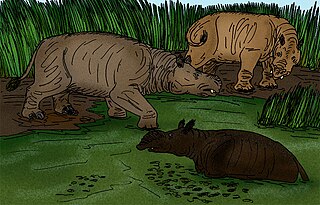 W
WAmynodontidae is a family of extinct perissodactyls related to true rhinoceroses. They are commonly portrayed as semiaquatic hippo-like rhinos but this description only fits members of the Metamynodontini; other groups of amynodonts like the cadurcodontines had more typical ungulate proportions and convergently evolved a tapir-like proboscis. Their fossils have been found in North America, and Eurasia ranging in age from the Middle Eocene to the Early Oligocene, with a single genus (Cadurcotherium) surviving into the Late Oligocene in South Asia (Pakistan). The genus Metamynodon may have survived into the early Miocene.
 W
WAstrapotheria is an extinct order of South American and Antarctic hoofed mammals that existed from the Late Paleocene to the Middle Miocene, 59 to 11.8 million years ago. Astrapotheres were large and rhinoceros-like animals and have been called one of the most bizarre orders of mammals with an enigmatic evolutionary history.
 W
WAstrapotheriidae is an extinct family of herbivorous South American land mammals that lived from the Late Eocene to the Middle Miocene 37.8 to 15.97 million years ago. The most derived of the astrapotherians, they were also the largest and most specialized mammals in the Tertiary of South America. There are two sister taxa: Eoastrapostylopidae and Trigonostylopidae.
 W
WBorhyaenidae is an extinct metatherian family of low-slung, heavily built predatory mammals in the order Sparassodonta. Borhaenids are not true marsupials, but members of a sister taxon, Sparassodonta. Like most metatherians, borhyaenids and other sparassodonts are thought to have had a pouch to carry their offspring around. Borhyaenids had strong and powerful jaws, like those of the unrelated placentalians Hyaenodon and Andrewsarchus, for crushing bones. Borhyaenids grew up to an average of 5 to 6 feet long. Borhyaena is the type genus of this group.
 W
WCebupithecia is an extinct genus of New World monkeys from the Middle Miocene. Its remains have been found at the Konzentrat-Lagerstätte of La Venta in the Honda Group of Colombia. The type species is C. sarmientoi.
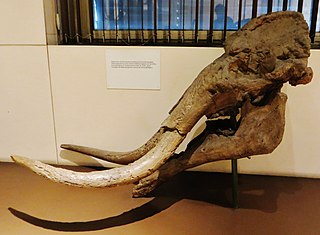 W
WChoerolophodontidae is an extinct family of large herbivorous mammals that were closely related to elephants. Two genera are known, Afrochoerodon and Choerolophodon.
 W
WClimacoceratidae is a family of superficially deer-like artiodactyl ungulates which lived in the Miocene epoch in Africa. They are close to the ancestry of giraffes, with some genera, such as Prolibytherium, originally classified as giraffes.
 W
WDesmatophocidae is an extinct family of pinnipeds closely related to true seals.
 W
WDiplocynodontinae is a clade of alligatoroid crocodilians that lived from the Eocene to the Miocene in Europe. It includes 10 species and two genera, Diplocynodon and Baryphracta, although Baryphracta may be a junior synonym of Diplocynodon. The fossil range of the group may extend back into the Paleocene depending on whether remains of an alligatoroid from Berru, France belong to a diplocynodontine.
 W
WDryopithecini is an extinct tribe of Eurasian and African great apes that are believed to be close to the ancestry of gorillas, chimpanzees and humans. Members of this tribe are known as dryopithecines.
 W
WThe Eocardiidae are an extinct family of caviomorph rodents from South America. The family is probably ancestral to the living family Caviidae, which includes cavies, maras, and capybaras and their relatives. McKenna and Bell (1997) divided eocardiids into two subfamilies, Luantinae for two of the oldest genera and Eocardiinae for remaining genera. Kramarz (2006) has recommended the abandonment of these subfamilies, as the genera placed in Luantinae appear to represent basal eocardiids, rather than a specialized side branch. The latter hypothesis had been proposed by Wood and Patterson (1959).
 W
WEuzaphlegidae is a family of extinct escolar-like fish closely related to the snake mackerels. Fossils of euzaphlegids are found from Paleocene to Late Miocene-aged marine strata of Europe, the Caucasus Mountains, India, Iran, Turkmenistan, Italy, and Southern California.
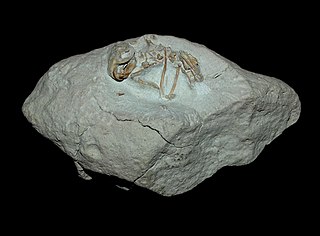 W
WHeliscomyidae is a family of extinct rodents from the mid-Tertiary of North America related to pocket gophers and kangaroo rats and their relatives. The family contains four genera, Apletotomeus, Heliscomys, Passaliscomys, and Tylionomys. McKenna and Bell (1997) placed the first two genera in synonymy, with Heliscomys the senior synonym.
 W
WHerpetotheriidae is an extinct family of metatherians. Although sometimes placed in the living opossum family, they may form the sister clade to all living marsupials. Species of this family are generally reconstructed as terrestrial. Fossils of herpetotheriids come from North America, Asia, Europe, Africa, and perhaps South America. The oldest representative is Maastrichtidelphys from the latest Cretaceous (Maastrichtian) of the Netherlands and the youngest member is Amphiperatherium from the Middle Miocene of Europe.
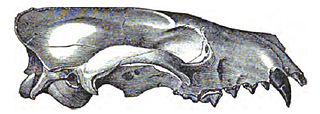 W
WThe extinct Hesperocyoninae are one of three subfamilies found within the canid family. The other two canid subfamilies are the extinct Borophaginae and extant Caninae.
 W
WHomalodotheriidae is an extinct family comprising four genera of notoungulate mammals known from the Late Eocene (Tinguirirican) through Late Miocene (Chasicoan) of Argentina and Chile in South America.
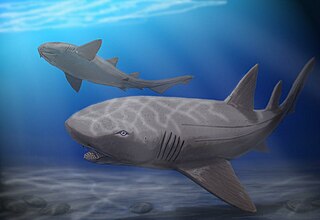 W
WHybodontiformes, also called hybodonts, are an extinct subset of Elasmobranchii which existed from the Devonian to the Miocene. They form the group of sharks closest to neoselachians, the clade of modern sharks and rays. Hybodonts were named and are distinguished based on their conical tooth shape. They comprised the main group of Jurassic sharks in Europe and North America. They survived into the Late Cretaceous before going extinct, possibly due to competition from other sharks, though forms like Miosynechodus endured as recently as the Miocene. Lonchidion was one of the last hybodonts — its distinctive serrated fine spines occur in freshwater deposits from Wyoming alongside the fossils of the last dinosaurs, including Tyrannosaurus rex and Triceratops. Hybodontiformes are identified in the fossil record predominantly based on distinct teeth and fin spines. They were known to live in both fresh and salt water environments.
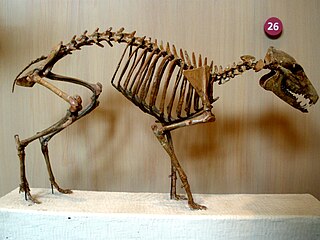 W
WHypertragulidae is an extinct family of artiodactyl ungulates that lived in North America, Europe, and Asia from the Eocene until the Miocene, living 46.2—13.6 million years ago, existing for about 33 million years.
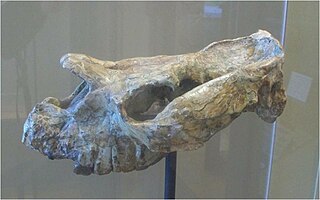 W
WLeontiniidae is an extinct family comprising eleven genera of notoungulate mammals known from the Middle Eocene (Mustersan) to Late Miocene (Huayquerian) of South America.
 W
WLeptomerycinae is an extinct subfamily within the ruminant family Leptomerycidae. It contains three genera, Leptomeryx, Pronodens, and Pseudoparablastomeryx, which lived in North America during the Middle Eocene to Middle Miocene. Leptomeryx may also have occurred in Asia during the Early Oligocene. Leptomerycies were primitive and ancient ruminants, resembling small deer or musk deer, although they were more closely related to modern chevrotains.
 W
WMerycoidodontoidea, sometimes called "oreodonts" or "ruminating hogs", is an extinct superfamily of prehistoric cud-chewing artiodactyls with short faces and fang-like canine teeth. As their name implies, some of the better known forms were generally hog-like, and the group has traditionally been placed within the Suina, though some recent work suggests they may have been more closely related to camels. "Oreodont" means "mountain teeth", referring to the appearance of the molars. Most oreodonts were sheep-sized, though some genera grew to the size of cattle. They were heavy-bodied, with short four-toed hooves and comparatively long tails.
 W
WNotosuchia is a suborder of primarily Gondwanan mesoeucrocodylian crocodylomorphs that lived during the Jurassic and Cretaceous. Some phylogenies recover Sebecosuchia as a clade within Notosuchia, others as a sister group ; if Sebecosuchia is included within Notosuchia its existence is pushed into the Middle Miocene, about 11 million years ago. Fossils have been found from South America, Africa, Asia, and Europe. Notosuchia was a clade of terrestrial crocodilians that evolved a range of feeding behaviours, including herbivory (Chimaerasuchus), omnivory (Simosuchus), and terrestrial hypercarnivory (Baurusuchus). It included many members with highly derived traits unusual for crocodylomorphs, including mammal-like teeth, flexible bands of shield-like body armor similar to those of armadillos (Armadillosuchus), and possibly fleshy cheeks and pig-like snouts (Notosuchus). The suborder was first named in 1971 by Zulma Gasparini and has since undergone many phylogenetic revisions.
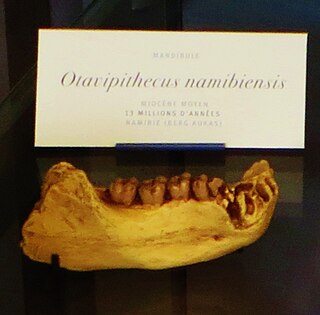 W
WOtavipithecus namibiensis is an extinct species of ape from the Miocene of Namibia. The fossils were discovered at the Berg Aukas mines in the foothills of the Otavi mountains, hence the generic name. The species was described in 1992 by Glenn Conroy and colleagues, and was at the time the only non-hominin fossil ape known from southern Africa. The fossils consist of part of the lower jawbone with molars, a partial frontal bone, a heavily damaged ulna, one vertebra and a partial finger bone.
 W
WOtavipithecus namibiensis is an extinct species of ape from the Miocene of Namibia. The fossils were discovered at the Berg Aukas mines in the foothills of the Otavi mountains, hence the generic name. The species was described in 1992 by Glenn Conroy and colleagues, and was at the time the only non-hominin fossil ape known from southern Africa. The fossils consist of part of the lower jawbone with molars, a partial frontal bone, a heavily damaged ulna, one vertebra and a partial finger bone.
 W
WThe Palaeomerycidae are an extinct family of ruminants in the order Artiodactyla, probably ancestral to deer and musk deer. Palaeomerycids lived in North America, Europe, Africa, Asia, and South America from 33 to 4.9 million years ago, existing for about 28 million years.
 W
WThe Phiomyidae are a family of prehistoric rodents from Africa and Eurasia. A 2011 study placed Gaudeamus in a new family, Gaudeamuridae.
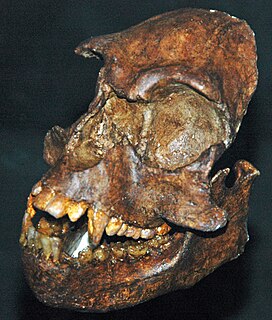 W
WPliopithecoidea is an extinct superfamily of catarrhine primates that inhabited Asia and Europe during the Miocene. Although they were once a widespread and diverse group of primates, the pliopithecoids have no living descendants.
 W
WPraekogia is an extinct genus of cetacean in the family Kogiidae that lived during the Miocene, containing one species: P. cedrosensis. Fossils have been found in Mexico.
 W
WProconsulidae is an early family of primates that lived during the Miocene epoch in Kenya, and was restricted to Africa. The family is split into two subfamilies.
 W
WPtolemaiida is a taxon of wolf-sized afrothere mammals that lived in northern and eastern Africa during the Paleogene. The oldest fossils are from the latest Eocene strata of the Jebel Qatrani Formation, near the Fayum oasis in Egypt. A tooth is known from an Oligocene-aged stratum in Angola, and Miocene specimens are known from Kenya and Uganda
 W
WSebecia is an extinct clade of mesoeucrocodylian crocodyliforms that includes peirosaurids and sebecids. It was first constructed in 2007 to include Hamadasuchus, Peirosauridae, and Sebecus. It was initially considered to be the sister taxon of the clade Neosuchia, which includes living crocodilians, although some later studies have placed it within Neosuchia as a basal clade. Sebecians were terrestrial crocodyliforms characterized by their deep snouts and ziphodont dentition. They first appeared in the Late Cretaceous, survived the Cretaceous–Paleogene extinction event, and became extinct in the Miocene epoch.
 W
WSebecidae is an extinct family of prehistoric terrestrial sebecosuchian crocodylomorphs. The oldest known member of the group is Ogresuchus furatus known from the Upper Cretaceous (Maastrichtian) Tremp Formation (Spain). Sebecids were diverse, abundant and broadly distributed in South America during the Cenozoic, until the Middle Miocene; although it has been suggested that at least some forms could have survived until the Miocene-Pliocene boundary in Brazil.
 W
WSqualodontidae or the shark-toothed dolphins is an extinct family of large toothed whales who had long narrow jaws. Squalodontids are known from all continents except Antarctica, from the Oligocene to the Neogene, but they had a maximal diversity and global distribution during the Late Oligocene and Early to Middle Miocene.
 W
WStenoplesictidae is the name of a polyphyletic family of extinct civet-like feliforms.
 W
WXiphiorhynchus is an extinct genus of prehistoric swordfish that lived from the Eocene until the Miocene. Unlike the modern swordfish, both the upper and lower jaws of Xiphiorhynchus were extended into blade-like points.
 W
WZiphosuchia is a clade of mesoeucrocodylian crocodyliforms that includes notosuchians and sebecosuchia